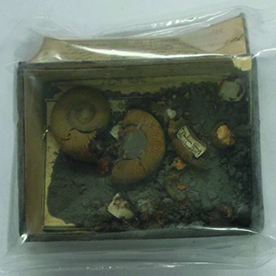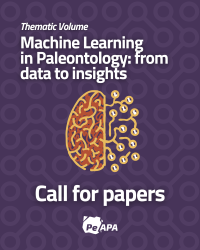ENVIRONMENTAL RISK AND PREVENTIVE CONSERVATION IN PALEONTOLOGICAL COLLECTIONS: AN INCOMING APPROACH IN ARGENTINA
Español
DOI:
https://doi.org/10.5710//PEAPA.05.12.2020.341Keywords:
Environmental risk, Preventive conservation, Paleontology, ArgentinaAbstract
The preventive conservation of heritage assets was initially associated with the environmental variables of the museums in which they are stored. Paleontological collections, although less susceptible than other biological collections, are no stranger to this problem. However, the scientific community has often been reluctant to this reality. At the beginning of the 1970s, institutions of the United Kingdom, the United States of America, Canada, and some European countries provided the impulse to this issue with the publication of numerous contributions that discussed in detail the causes and mitigating methods of potential damage to fossils; recently, they included non-invasive spectrometric techniques to case studies. This paper aims to synthesize the knowledge of the environmental factors that represent a risk for paleontological collections, a subject whose approach is incipient in our country as part of preventive conservation.
References
Allington-Jones, L. y A. Trafford. (2017). The Airless Project. Evolving Ideas: Provocative new ways of working with collections. Natural Sciences Collections Association Conference. Cambridge. http://www.natsca.org/poster/2384
Álvarez, S. M. (2012). Recientes avances en las Colecciones de Vertebrados fósiles del Museo Argentino de Ciencias Naturales “Bernardino Rivadavia”. Ameghiniana, Suplemento Resúmenes, 49(4), 84R.
Andrew, K. J. (1996). A summary of the care and preventive conservation of sub-fossil bone for the non-specialist or Pleistocene problems- the sub-fossil bone scenario. The Biology Curator, 5, 24–28.
Baars, C. y Horak, J. (2018). Storage and conservation of geological collections-a research agenda. Journal of the Institute of Conservation, 41(2), 154–168. https://doi.org/10.1080/19455224. 2018.1463921
Baeza Chico, E. y Menéndez, S. (2005). Conservación y Restauración de ammonites piritizados del Museo Geominero (IGME, Madrid). 2° Congreso del Grupo Español del International Institute for Conservation of historic and artistic work (p. 47). Barcelona.
Barrón-Ortiz, C. I., Sawchuk, M. R., Li, C. y Jass, C. N. (2018). Conservation of subfossil bones from a lacustrine setting: Uncontrolled and controlled drying of Late Quaternary vertebrate remains from Cold Lake, Western Canada. Collection Forum, 32(1–2), 1–13. https://doi.org/10.14351/0831-4985-32.1.1
Bassett, M. G. (1979). Curation of palaeontological collections. Special Papers in Palaeontology, 22, 1–280.
Bather, F. A. (1908). The preparation and preservation of fossils. The Museums Journal, 8, 76–91.
Becherini, F., Del Favero, L., Fornasiero, M., Guastoni, A. y Bernardi, A. (2018). Pyrite decay of large fossils: The case study of the Hall of Palms in Padova, Italy. Minerals, 8(2), 40. https://doi.org/10.3390/min8020040
Bisulca, C., Nascimbene, P. C., Elkin, L. y Grimaldi, D. A. (2012). Variation in the deterioration of fossil resins and implications for the conservation of fossils in amber. American Museum Novitates, 3734, 1–19. https://doi.org/10.1206/3734.2
Buttler, C. J. (1994a). Environmental effects on geological material: Pyrite decay. En R. E. Child (Ed.), Conservation of Geological Collections (pp. 4–8). Archetype Publications Limited.
Buttler, C. J. (1994b). Damage to sub-fossil bone. En R. E. Child (Ed.), Conservation of Geological Collections (pp. 9–13). Archetype Publications Limited.
Collinson, M. E. (1986). Special problems in the conservation of palaeobotanical material. Geological Curator, 4(7), 439–445.
Cornish, L. (1986). The treatment of decaying pyritiperous fossil material using ethanolamine thioglycolate. Geological Curator, 4(7), 451–454.
Cornish, L. y Doyle, M. A. (1984). Use of ethanolamine thioglycolate in the conservation of pyritized fossils. Palaeontology, 27(2), 421–424.
Corral, J. C. (1999). La conservación del ámbar: revisión de los principales agentes de deterioro y soluciones publicados. Estudios del Museo de Ciencias Naturales de Álava, 14(2), 23–32.
Corral, J. C. (2012). Técnicas aplicadas en la preparación de un cráneo cuaternario de Panthera pardus (Linneo, 1758) de Ataun (cueva Allekoaitze, Guipúzcoa, España). Boletín Geológico y Minero, 123(2), 127–138.
Crespo, C. y Viñas, V. (1984). La preservación y restauración de documentos y libros en papel: un estudio del RAMP con directrices. Programa General de Información y UNISIST, Organización de las Naciones Unidas para la Educación, la Ciencia y la Cultura. http://unesdoc.unesco.org/images/0006/000635/063519so.pdf
de Guichen, G. (1999). La conservación preventiva: ¿Simple moda pasajera o cambio trascendental? Museum International, 201(51), 4–6.
Del Favero, L., Fornasiero, M., Molin, G., Reggiani, P. y Zorzi, F. (2012). Il restauro dei vegetali fossili esposti nella “Sala delle Palme” del Museo di Geologia e Paleontologia dell’Università di Padova. Museologia Scientifica, 6(1–2), 49–57.
Doyle, A. M. (1983). The conservation of sub-fossil bird bone. Geological Curator, 3(7), 447–451.
Doyle, A. M. (2003). A large scale “Microclimate” enclosure for pyritic specimens. Geological Curator, 7(9), 329–335.
Druetta, S., Salas, M. J. y Sterren, A. F. (2017). Acciones de conservación preventiva en la “Colección Centro de Investigaciones Paleobiológicas” (CIPAL). Ameghiniana, Suplemento Resúmenes, 54(4), 77R.
Elder, A., Madsen, S., Brown, G., Herbel, C., Collins, C., Whelan, S., Wenz, C., Alderson, S. y Kronthal, L. (1997). Adhesives and consolidants in geological and paleontological applications: A Wall Chart. SPNHC Leaflets, 1(2), 1–2.
Garat, G. y Milani, M. (2011). Técnicas de restauración de fósiles. Caso: húmero holotipo de Panamericansaurus schroederi Calvo y Porfiri, 2010. Ameghiniana, Suplemento Resúmenes, 48(4), 166R.
García Fernández, I. M. (2013). Historia de la conservación preventiva. Parte I. Geoconservación, 5, 27–41. https://doi.org/10.37558/gec.v5i0.195
Grimaldi, D. (1993). The care and study of fossiliferous amber. Curator The Museum Journal, 36(1), 31–49. https://doi.org/10.1111/j.2151-6952.1993.tb00775.x
Hodgkinson, E. S. y Martin, S. (2004). History and mineralisation of highly degraded pyrite fossil collection. [Informe n° IR/04/037]. British Geological Survey. http://nora.nerc.ac.uk/id/eprint/509280/1/IR04037.pdf
Holmberg, I. C. (2000). Different degradation effects on Miocene whale skeletal remains from Gram, Denmark, caused by the clay matrix. Collection Forum, 14(1–2). https://spnhc.org/wp-content/uploads/2018/11/CFAbs_2000_V14N12.pdf
Howie, F. M. P. (1978). Storage environment and the conservation of geological material. The Conservator, 2(1), 13–19.
Howie, F. M. P. (1979a). Museum climatology and the conservation of palaeontological material. Special Papers in Palaeontology, 22, 103–126.
Howie, F. M. P. (1979b). Physical conservation of fossils in existing collections. Newsletter of the Geological Curators Group, 2(5), 269–280.
Larkin, N. (2011). Pyrite Decay: cause and effect, prevention and cure. NatSCA News, 21, 35–43.
Luna, C. A., Prieto, M. C., Miño-Boilini, A. R., Espíndola, V. E. y Zurita, A. E. (2019). Conservación preventiva en la colección de verte brados fósiles de la Universidad Nacional del Nordeste, Argentina. Publicación Electrónica de la Asociación Paleontológica Argentina, 19(1R), R37–38.
Marcos-Fernández, F., Plaza Beltrán, M. y Ortega, F. (2018). La conservación preventiva de material paleontológico, la colección de Lo Hueco. 6° Congreso del Grupo Español del International Institute for Conservation of historic and artistic work (pp. 402–410). Vitoria-Gasteiz.
McDonald, G., Elder, A. y Shelton, S. (2005). Curatorial Care of Paleontological and Geological Collections. En The Museum Handbook, Part I: Museum Collections (pp. U1–U54). National Park Service.
Montero, A. y Diéguez, C. (2001). Colecta y conservación de fósiles. Enseñanza de las Ciencias de la Tierra, 9(2), 121–126.
Museums and Galleries Commission. (1992). Standards in the museum care of biological collections. Spin Offset Limited.
Museums, Libraries and Archives Council. (2004). Standards in the Museum Care of Geological Collections. https://collectionstrust.org.uk/resource/geological-collections-a-guide-to-standards-in-theirpreservation-and-care/
National Park Service. (1998). Storage concerns for geological collections. Conserve O Gram, 11(2), 1–4.
Neuhaus, B., Schmid, T. y Riedel, J. (2017). Collection management and study of microscope slides: Storage, profiling, deterioration, restoration procedures, and general recommendations. Zootaxa, 4322(1), 1–173. https://doi.org/10.11646/zootaxa.4322.1.1
Newman, A. (1998). Pyrite oxidation and museum collections: a review of theory and conservation treatments. Geological Curator, 6(10), 363–371.
Oddy, A. (2011). Harold Plenderleith and the conservation of antiquities and works of art. Intervención (México DF), 2(4), 56–62.
Odin, G. P., Chabard, D. y Rouchon, V. (2013). étude de collections de paléontologie. De la caractérisation à la reproduction des altérations de fossiles dits pyriteux. En CeROArt (Online), Hors Série. http://journals.openedition.org/ceroart/3409
Pastorelli, G., Richter, J. y Shashoua, Y. (2011). Photoageing of Baltic amber - Influence of daylight radiation behind window glass on surface colour and chemistry. Polymer Degradation and Stability, 96(11), 1996–2001.
Rojas, A., Cabrera, F. y Corona, A. (2020). Temperature and relative humidity in a palaeontological collection: the buffering effect of microenvironments. Annales de Paléontologie, 106(4), 102446. https://doi.org/10.1016/j.annpal.2020.102446.
Rouchon, V., Badet, H., Belhadj, O., Bonnerot, O., Lavédrine, B., Michard, J.-G. y Miska, S. (2012). Raman and FTIR spectroscopy applied to the conservation report of paleontological collections: identification of Raman and FTIR signatures of several iron sulfate species such as ferrinatrite and sideronatrite. Journal of Raman Spectroscopy, 43(9), 1265–1274.
Shelton, S. Y. (1994). Conservation of vertebrate paleontological collections. En P. Leiggi y P. May (Eds.), Vertebrate paleontological techniques (vol. 1, pp. 3–34). Cambridge University Press.
Shinya, A. y Bergwall, L. (2007). Pyrite oxidation: Review and prevention practices. 67th Annual Meeting of the Society of Vertebrate Paleontology, Austin. https://vertpaleo.org/education/documents/Shinya_and_Bergwall_2007.pdf
Shute, C. H. y Cleal, C. J. (1987). Palaeobotany in Museums. Geological Curator, 4(9), 553–559.
Simmons J. E. y Muñoz-Saba, Y. (2005). Conservación preventiva y causa de deterioro de las colecciones. En J. E. Simons e Y. Muñoz-Zaba (Eds.), Cuidado, manejo y conservación de las colecciones biológicas: Conservación Internacional Serie Manuales para la conservación 1 (pp. 54–71). Universidad Nacional de Colombia.
Sterflinger, K. (2010). Fungi: Their role in deterioration of cultural heritage. Fungal Biology Review, 24(1–2), 47–55. https://doi.org/10.1016/j.fbr.2010.03.003
Stooshnov, A. y Buttler, C. (2001). The treatment of specimen labels affected by pyrite decay. Geological Curator, 7(5), 175–180.
Waddington, J. (2000). Conservation guidelines for invertebrate paleontology collections. The Paleontological Society Special Publications, 10, 93–104. https://doi.org/10.1017/S2475262200009011
White, R. D. (2000). Guidelines for the documentation and care of invertebrate fossil collections. The Paleontological Society Special Publications, 10, 51–64. https://doi.org/10.1017/S2475262200008960

Downloads
Published
Issue
Section
License
Authors retain copyright and grant the journal right of first publication with the work simultaneously licensed under a Atribución/Reconocimiento 4.0 Internacional that allows others to share the work with an acknowledgement of the work's authorship and initial publication in this journal.
















